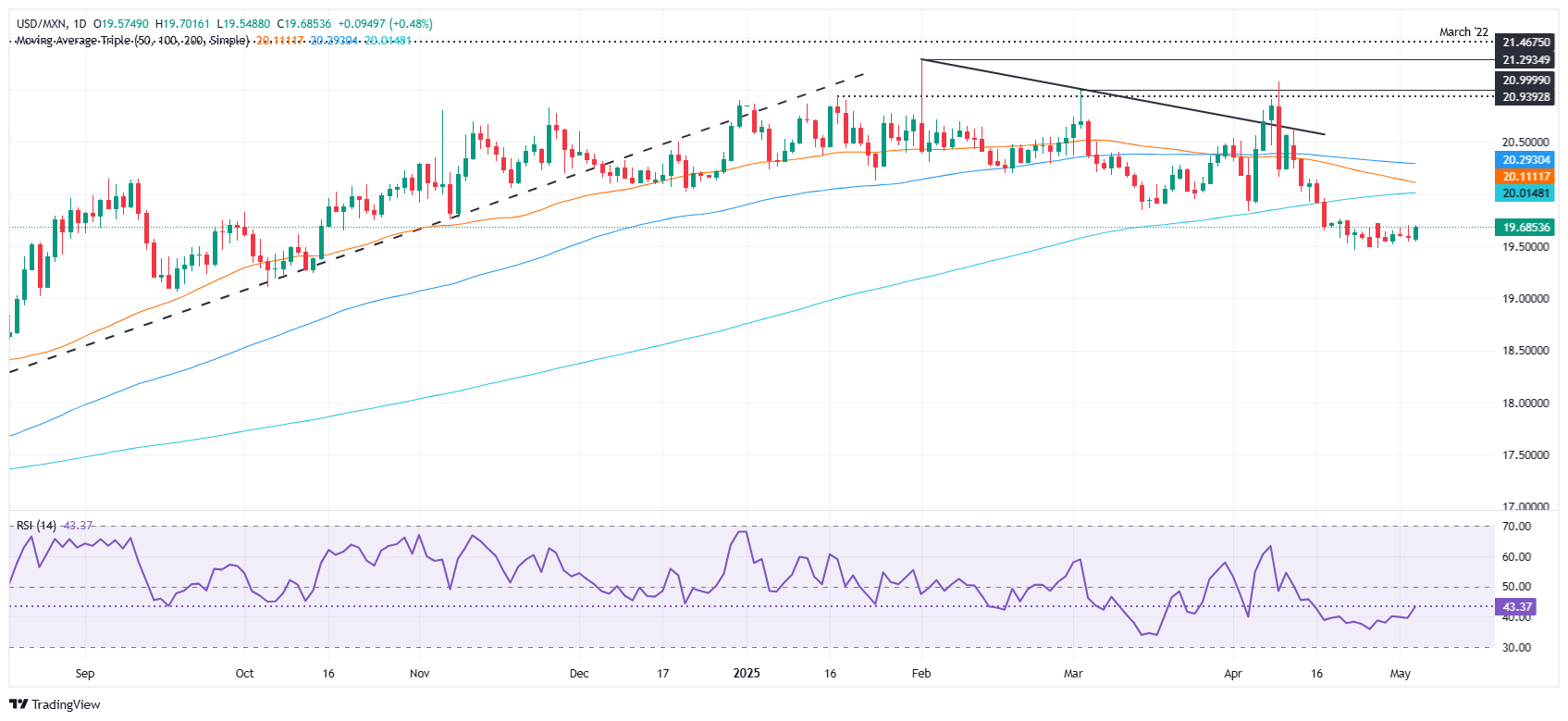Created
: 2025.05.06














![]() 2025.05.06 08:43
2025.05.06 08:43
The Mexican Peso (MXN) began the week with losses of around 0.58% against the US Dollar (USD) ahead of a crucial week with the Federal Reserve (Fed) preparing to host its monetary policy meeting on May 7 and the announcement of Mexican inflation figures. At the time of writing, the USD/MXN trades at 19.67.
Market participants continued to digest US trade-related news, with Washington signaling possible deals with India, South Korea, and Japan. Although US President Donald Trump said that China wants a deal "very badly," Beijing's lack of confirmation of a start of discussions keeps investors on their toes.
Mexico's economic docket on Monday was absent, with traders eyeing the release of April's Consumer Price Index (CPI) on May 8. In March, inflation stood at 3.8% YoY and Core CPI at 3.64%. Although prices remained within the Banco de Mexico's (Banxico) 3% plus-or-minus 1% band, a further reacceleration would exert pressure on Banxico, which embarked on an easing cycle.
In other news, Reuters revealed that Mexican President Claudia Sheinbaum and US President Donald Trump discussed a US military incursion into Mexico to combat the drug cartels. Nevertheless, Sheinbaum turned down the offer, saying at an event, "We can work together, but you in your territory and us in ours."
Across the northern border, the Institute for Supply Management (ISM) revealed that services activity improved in April. A sub-component of the reading suggested that US businesses reported a jump in Prices Paid.
The USD/MXN remains sensitive to shifts in market mood as well. Traders are eyeing the Fed's monetary policy, with expectations of the US central bank keeping rates unchanged. Nevertheless, traders are eyeing Fed Chair Jerome Powell's tone at the post-meeting press conference.
The USD/MXN downtrend remains intact, but it seems the pair found its foot, bottoming near the 19.46-19.50 range, with sellers unable to push prices lower. Buyers are gathering momentum as reflected by the Relative Strength Index (RSI); hence a test of the 200-day SMA at 19.98 is on the cards. A breach of the latter will expose the 20.00 mark, followed by the 100-day SMA at 20.26.
Conversely, the USD/MXN falling below 19.46 could exacerbate a fall towards the 19.00 mark, ahead of the June 28 high-turned-support at 18.59.

The Mexican Peso (MXN) is the most traded currency among its Latin American peers. Its value is broadly determined by the performance of the Mexican economy, the country's central bank's policy, the amount of foreign investment in the country and even the levels of remittances sent by Mexicans who live abroad, particularly in the United States. Geopolitical trends can also move MXN: for example, the process of nearshoring - or the decision by some firms to relocate manufacturing capacity and supply chains closer to their home countries - is also seen as a catalyst for the Mexican currency as the country is considered a key manufacturing hub in the American continent. Another catalyst for MXN is Oil prices as Mexico is a key exporter of the commodity.
The main objective of Mexico's central bank, also known as Banxico, is to maintain inflation at low and stable levels (at or close to its target of 3%, the midpoint in a tolerance band of between 2% and 4%). To this end, the bank sets an appropriate level of interest rates. When inflation is too high, Banxico will attempt to tame it by raising interest rates, making it more expensive for households and businesses to borrow money, thus cooling demand and the overall economy. Higher interest rates are generally positive for the Mexican Peso (MXN) as they lead to higher yields, making the country a more attractive place for investors. On the contrary, lower interest rates tend to weaken MXN.
Macroeconomic data releases are key to assess the state of the economy and can have an impact on the Mexican Peso (MXN) valuation. A strong Mexican economy, based on high economic growth, low unemployment and high confidence is good for MXN. Not only does it attract more foreign investment but it may encourage the Bank of Mexico (Banxico) to increase interest rates, particularly if this strength comes together with elevated inflation. However, if economic data is weak, MXN is likely to depreciate.
As an emerging-market currency, the Mexican Peso (MXN) tends to strive during risk-on periods, or when investors perceive that broader market risks are low and thus are eager to engage with investments that carry a higher risk. Conversely, MXN tends to weaken at times of market turbulence or economic uncertainty as investors tend to sell higher-risk assets and flee to the more-stable safe havens.
![]()
Created
: 2025.05.06
![]()
Last updated
: 2025.05.06

FXStreet is a forex information website, delivering market analysis and news articles 24/7.
It features a number of articles contributed by well-known analysts, in addition to the ones by its editorial team.
Founded in 2000 by Francesc Riverola, a Spanish economist, it has grown to become a world-renowned information website.
We hope you find this article useful. Any comments or suggestions will be greatly appreciated.
We are also looking for writers with extensive experience in forex and crypto to join us.
please contact us at [email protected].
Disclaimer:
All information and content provided on this website is provided for informational purposes only and is not intended to solicit any investment. Although all efforts are made in order to ensure that the information is correct, no guarantee is provided for the accuracy of any content on this website. Any decision made shall be the responsibility of the investor and Myforex does not take any responsibility whatsoever regarding the use of any information provided herein.
The content provided on this website belongs to Myforex and, where stated, the relevant licensors. All rights are reserved by Myforex and the relevant licensors, and no content of this website, whether in full or in part, shall be copied or displayed elsewhere without the explicit written permission of the relevant copyright holder. If you wish to use any part of the content provided on this website, please ensure that you contact Myforex.
Myforex uses cookies to improve the convenience and functionality of this website. This website may include cookies not only by us but also by third parties (advertisers, log analysts, etc.) for the purpose of tracking the activities of users. Cookie policy